Planning Delivering Assessing Learners in Own Specialist Area Report
VerifiedAdded on 2023/06/13
|23
|7096
|51
Report
AI Summary
This report explores the critical elements of teaching, learning, and assessment in education and training, focusing on their impact on learner efficiency. It highlights the roles and responsibilities of educators, including understanding learner needs, delivering instruction, and evaluating outcomes in a continuous teaching cycle. Key aspects of legislation, regulatory requirements, and codes of practice, such as the Health and Safety Act 1974, Equality Act 2010, and Data Protection Act 2003, are discussed in relation to creating a safe and inclusive learning environment. The report also examines the use of initial and diagnostic assessments to identify individual learning goals, the importance of meeting learners' specific needs through inclusive planning and motivation, and various learning models like Kolb's learning and Bloom's Taxonomy. Furthermore, it covers strategies for adapting teaching plans, promoting appropriate behavior and diversity, and utilizing different assessment methods to enhance learner achievement. The report concludes with a review of teaching effectiveness and areas for improvement.
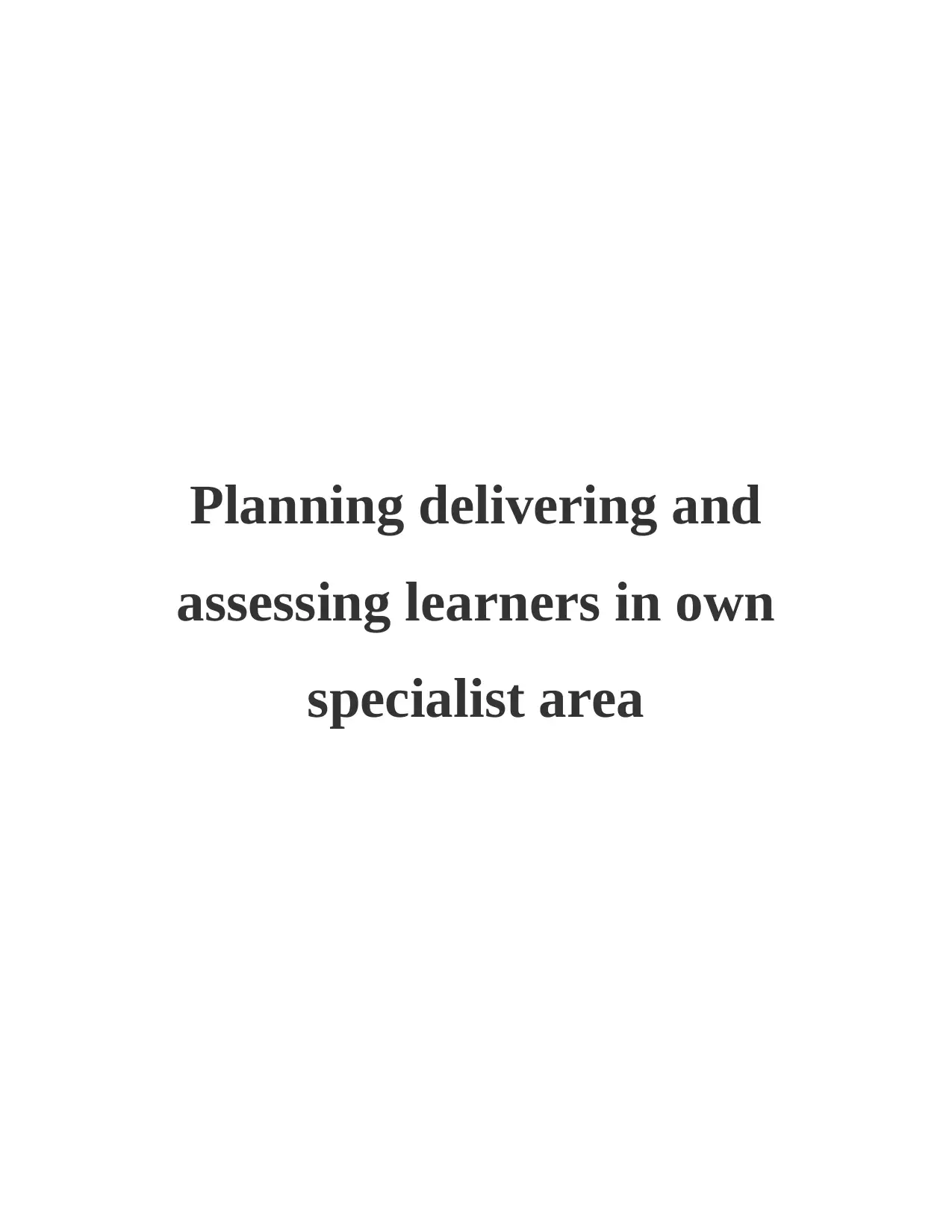
Planning delivering and
assessing learners in own
specialist area
assessing learners in own
specialist area
Paraphrase This Document
Need a fresh take? Get an instant paraphrase of this document with our AI Paraphraser
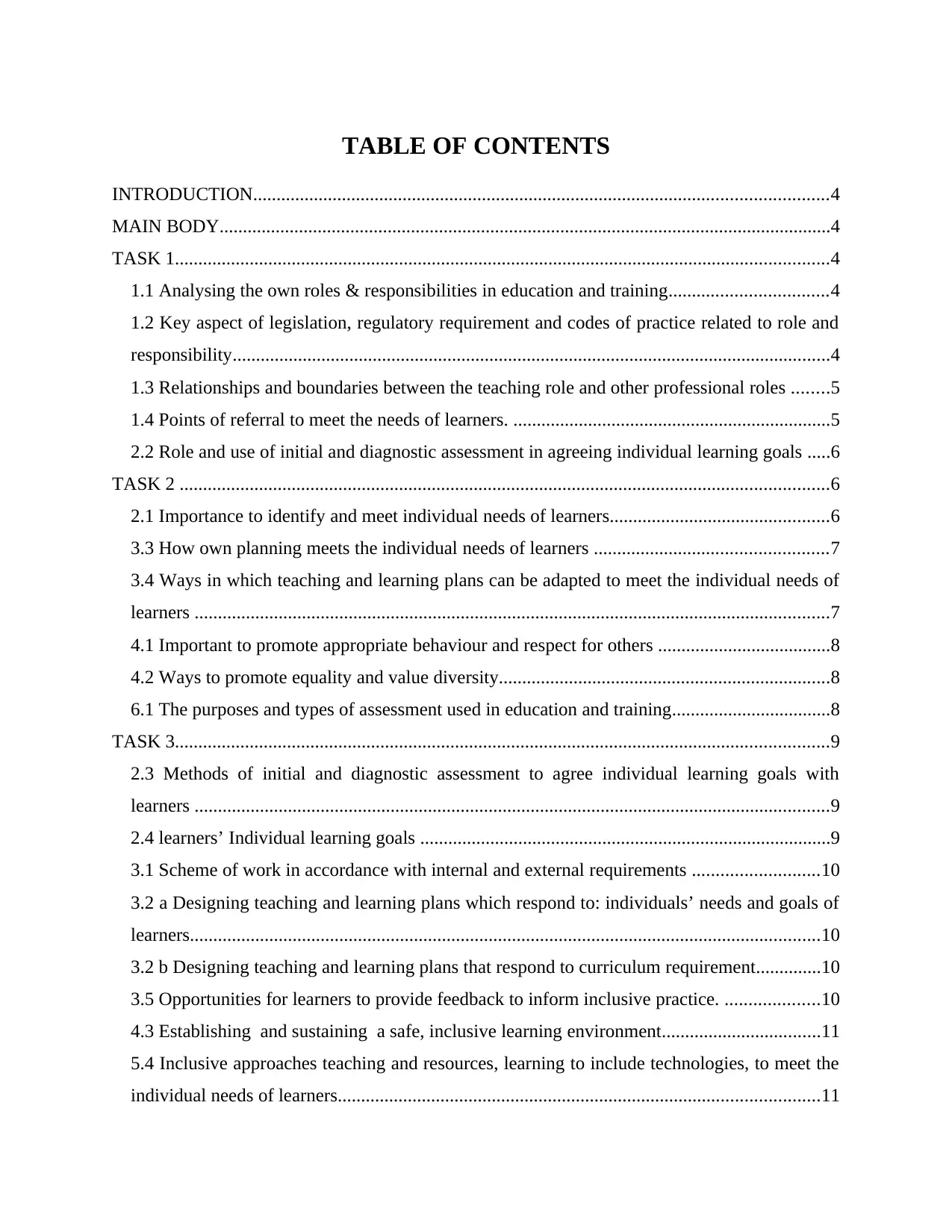
TABLE OF CONTENTS
INTRODUCTION...........................................................................................................................4
MAIN BODY...................................................................................................................................4
TASK 1............................................................................................................................................4
1.1 Analysing the own roles & responsibilities in education and training..................................4
1.2 Key aspect of legislation, regulatory requirement and codes of practice related to role and
responsibility................................................................................................................................4
1.3 Relationships and boundaries between the teaching role and other professional roles ........5
1.4 Points of referral to meet the needs of learners. ....................................................................5
2.2 Role and use of initial and diagnostic assessment in agreeing individual learning goals .....6
TASK 2 ...........................................................................................................................................6
2.1 Importance to identify and meet individual needs of learners...............................................6
3.3 How own planning meets the individual needs of learners ..................................................7
3.4 Ways in which teaching and learning plans can be adapted to meet the individual needs of
learners ........................................................................................................................................7
4.1 Important to promote appropriate behaviour and respect for others .....................................8
4.2 Ways to promote equality and value diversity.......................................................................8
6.1 The purposes and types of assessment used in education and training..................................8
TASK 3............................................................................................................................................9
2.3 Methods of initial and diagnostic assessment to agree individual learning goals with
learners ........................................................................................................................................9
2.4 learners’ Individual learning goals ........................................................................................9
3.1 Scheme of work in accordance with internal and external requirements ...........................10
3.2 a Designing teaching and learning plans which respond to: individuals’ needs and goals of
learners.......................................................................................................................................10
3.2 b Designing teaching and learning plans that respond to curriculum requirement..............10
3.5 Opportunities for learners to provide feedback to inform inclusive practice. ....................10
4.3 Establishing and sustaining a safe, inclusive learning environment..................................11
5.4 Inclusive approaches teaching and resources, learning to include technologies, to meet the
individual needs of learners.......................................................................................................11
INTRODUCTION...........................................................................................................................4
MAIN BODY...................................................................................................................................4
TASK 1............................................................................................................................................4
1.1 Analysing the own roles & responsibilities in education and training..................................4
1.2 Key aspect of legislation, regulatory requirement and codes of practice related to role and
responsibility................................................................................................................................4
1.3 Relationships and boundaries between the teaching role and other professional roles ........5
1.4 Points of referral to meet the needs of learners. ....................................................................5
2.2 Role and use of initial and diagnostic assessment in agreeing individual learning goals .....6
TASK 2 ...........................................................................................................................................6
2.1 Importance to identify and meet individual needs of learners...............................................6
3.3 How own planning meets the individual needs of learners ..................................................7
3.4 Ways in which teaching and learning plans can be adapted to meet the individual needs of
learners ........................................................................................................................................7
4.1 Important to promote appropriate behaviour and respect for others .....................................8
4.2 Ways to promote equality and value diversity.......................................................................8
6.1 The purposes and types of assessment used in education and training..................................8
TASK 3............................................................................................................................................9
2.3 Methods of initial and diagnostic assessment to agree individual learning goals with
learners ........................................................................................................................................9
2.4 learners’ Individual learning goals ........................................................................................9
3.1 Scheme of work in accordance with internal and external requirements ...........................10
3.2 a Designing teaching and learning plans which respond to: individuals’ needs and goals of
learners.......................................................................................................................................10
3.2 b Designing teaching and learning plans that respond to curriculum requirement..............10
3.5 Opportunities for learners to provide feedback to inform inclusive practice. ....................10
4.3 Establishing and sustaining a safe, inclusive learning environment..................................11
5.4 Inclusive approaches teaching and resources, learning to include technologies, to meet the
individual needs of learners.......................................................................................................11
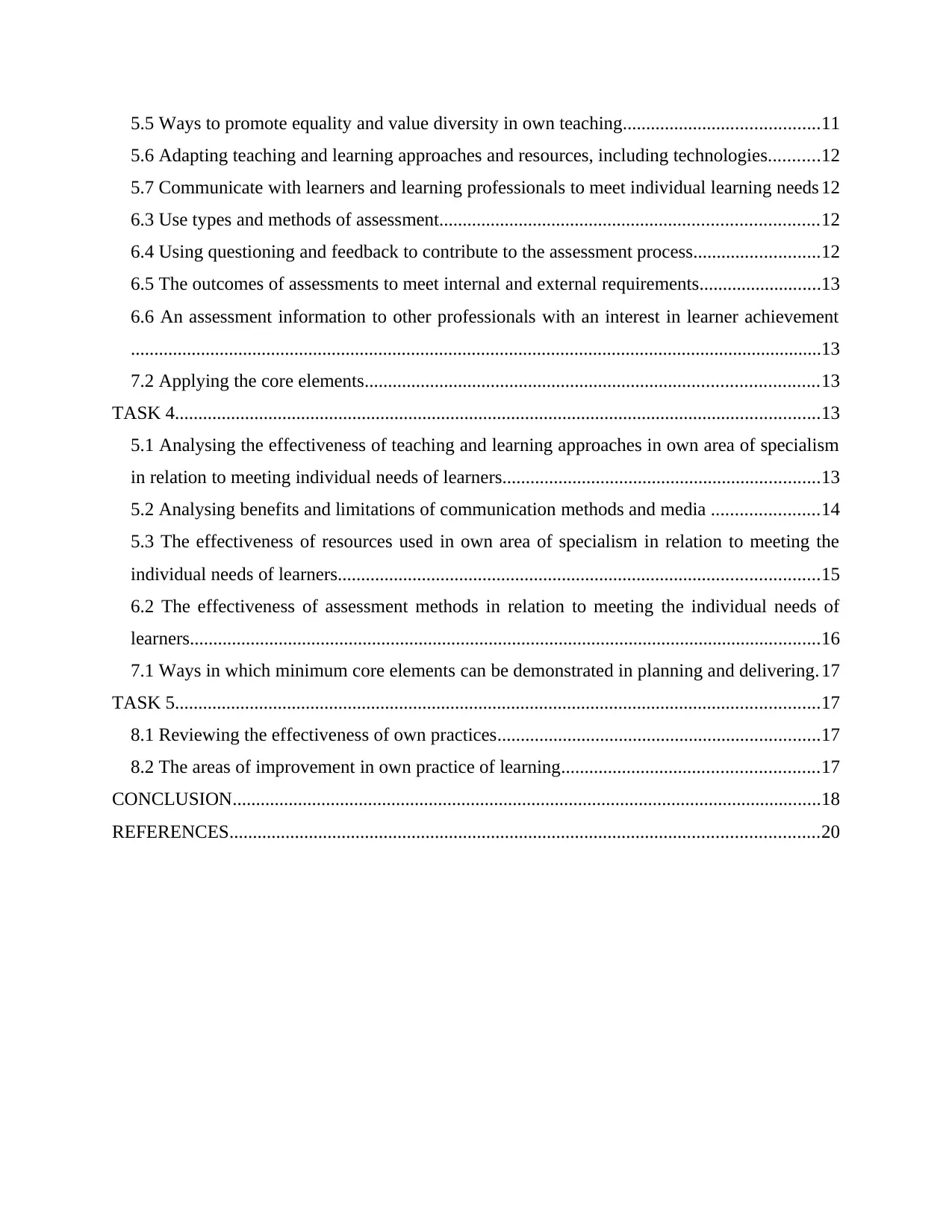
5.5 Ways to promote equality and value diversity in own teaching..........................................11
5.6 Adapting teaching and learning approaches and resources, including technologies...........12
5.7 Communicate with learners and learning professionals to meet individual learning needs 12
6.3 Use types and methods of assessment.................................................................................12
6.4 Using questioning and feedback to contribute to the assessment process...........................12
6.5 The outcomes of assessments to meet internal and external requirements..........................13
6.6 An assessment information to other professionals with an interest in learner achievement
....................................................................................................................................................13
7.2 Applying the core elements.................................................................................................13
TASK 4..........................................................................................................................................13
5.1 Analysing the effectiveness of teaching and learning approaches in own area of specialism
in relation to meeting individual needs of learners....................................................................13
5.2 Analysing benefits and limitations of communication methods and media .......................14
5.3 The effectiveness of resources used in own area of specialism in relation to meeting the
individual needs of learners.......................................................................................................15
6.2 The effectiveness of assessment methods in relation to meeting the individual needs of
learners.......................................................................................................................................16
7.1 Ways in which minimum core elements can be demonstrated in planning and delivering.17
TASK 5..........................................................................................................................................17
8.1 Reviewing the effectiveness of own practices.....................................................................17
8.2 The areas of improvement in own practice of learning.......................................................17
CONCLUSION..............................................................................................................................18
REFERENCES..............................................................................................................................20
5.6 Adapting teaching and learning approaches and resources, including technologies...........12
5.7 Communicate with learners and learning professionals to meet individual learning needs 12
6.3 Use types and methods of assessment.................................................................................12
6.4 Using questioning and feedback to contribute to the assessment process...........................12
6.5 The outcomes of assessments to meet internal and external requirements..........................13
6.6 An assessment information to other professionals with an interest in learner achievement
....................................................................................................................................................13
7.2 Applying the core elements.................................................................................................13
TASK 4..........................................................................................................................................13
5.1 Analysing the effectiveness of teaching and learning approaches in own area of specialism
in relation to meeting individual needs of learners....................................................................13
5.2 Analysing benefits and limitations of communication methods and media .......................14
5.3 The effectiveness of resources used in own area of specialism in relation to meeting the
individual needs of learners.......................................................................................................15
6.2 The effectiveness of assessment methods in relation to meeting the individual needs of
learners.......................................................................................................................................16
7.1 Ways in which minimum core elements can be demonstrated in planning and delivering.17
TASK 5..........................................................................................................................................17
8.1 Reviewing the effectiveness of own practices.....................................................................17
8.2 The areas of improvement in own practice of learning.......................................................17
CONCLUSION..............................................................................................................................18
REFERENCES..............................................................................................................................20
⊘ This is a preview!⊘
Do you want full access?
Subscribe today to unlock all pages.

Trusted by 1+ million students worldwide
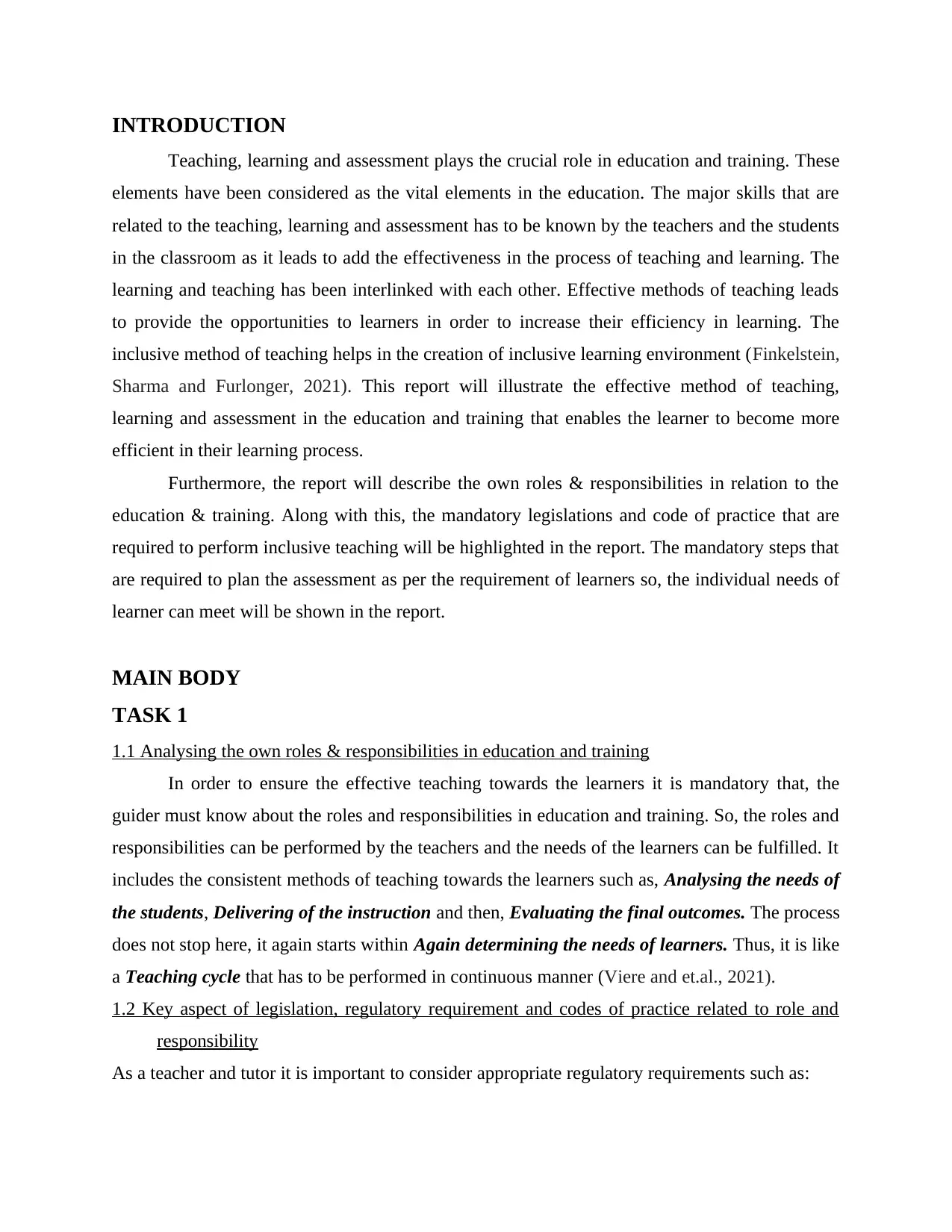
INTRODUCTION
Teaching, learning and assessment plays the crucial role in education and training. These
elements have been considered as the vital elements in the education. The major skills that are
related to the teaching, learning and assessment has to be known by the teachers and the students
in the classroom as it leads to add the effectiveness in the process of teaching and learning. The
learning and teaching has been interlinked with each other. Effective methods of teaching leads
to provide the opportunities to learners in order to increase their efficiency in learning. The
inclusive method of teaching helps in the creation of inclusive learning environment (Finkelstein,
Sharma and Furlonger, 2021). This report will illustrate the effective method of teaching,
learning and assessment in the education and training that enables the learner to become more
efficient in their learning process.
Furthermore, the report will describe the own roles & responsibilities in relation to the
education & training. Along with this, the mandatory legislations and code of practice that are
required to perform inclusive teaching will be highlighted in the report. The mandatory steps that
are required to plan the assessment as per the requirement of learners so, the individual needs of
learner can meet will be shown in the report.
MAIN BODY
TASK 1
1.1 Analysing the own roles & responsibilities in education and training
In order to ensure the effective teaching towards the learners it is mandatory that, the
guider must know about the roles and responsibilities in education and training. So, the roles and
responsibilities can be performed by the teachers and the needs of the learners can be fulfilled. It
includes the consistent methods of teaching towards the learners such as, Analysing the needs of
the students, Delivering of the instruction and then, Evaluating the final outcomes. The process
does not stop here, it again starts within Again determining the needs of learners. Thus, it is like
a Teaching cycle that has to be performed in continuous manner (Viere and et.al., 2021).
1.2 Key aspect of legislation, regulatory requirement and codes of practice related to role and
responsibility
As a teacher and tutor it is important to consider appropriate regulatory requirements such as:
Teaching, learning and assessment plays the crucial role in education and training. These
elements have been considered as the vital elements in the education. The major skills that are
related to the teaching, learning and assessment has to be known by the teachers and the students
in the classroom as it leads to add the effectiveness in the process of teaching and learning. The
learning and teaching has been interlinked with each other. Effective methods of teaching leads
to provide the opportunities to learners in order to increase their efficiency in learning. The
inclusive method of teaching helps in the creation of inclusive learning environment (Finkelstein,
Sharma and Furlonger, 2021). This report will illustrate the effective method of teaching,
learning and assessment in the education and training that enables the learner to become more
efficient in their learning process.
Furthermore, the report will describe the own roles & responsibilities in relation to the
education & training. Along with this, the mandatory legislations and code of practice that are
required to perform inclusive teaching will be highlighted in the report. The mandatory steps that
are required to plan the assessment as per the requirement of learners so, the individual needs of
learner can meet will be shown in the report.
MAIN BODY
TASK 1
1.1 Analysing the own roles & responsibilities in education and training
In order to ensure the effective teaching towards the learners it is mandatory that, the
guider must know about the roles and responsibilities in education and training. So, the roles and
responsibilities can be performed by the teachers and the needs of the learners can be fulfilled. It
includes the consistent methods of teaching towards the learners such as, Analysing the needs of
the students, Delivering of the instruction and then, Evaluating the final outcomes. The process
does not stop here, it again starts within Again determining the needs of learners. Thus, it is like
a Teaching cycle that has to be performed in continuous manner (Viere and et.al., 2021).
1.2 Key aspect of legislation, regulatory requirement and codes of practice related to role and
responsibility
As a teacher and tutor it is important to consider appropriate regulatory requirements such as:
Paraphrase This Document
Need a fresh take? Get an instant paraphrase of this document with our AI Paraphraser
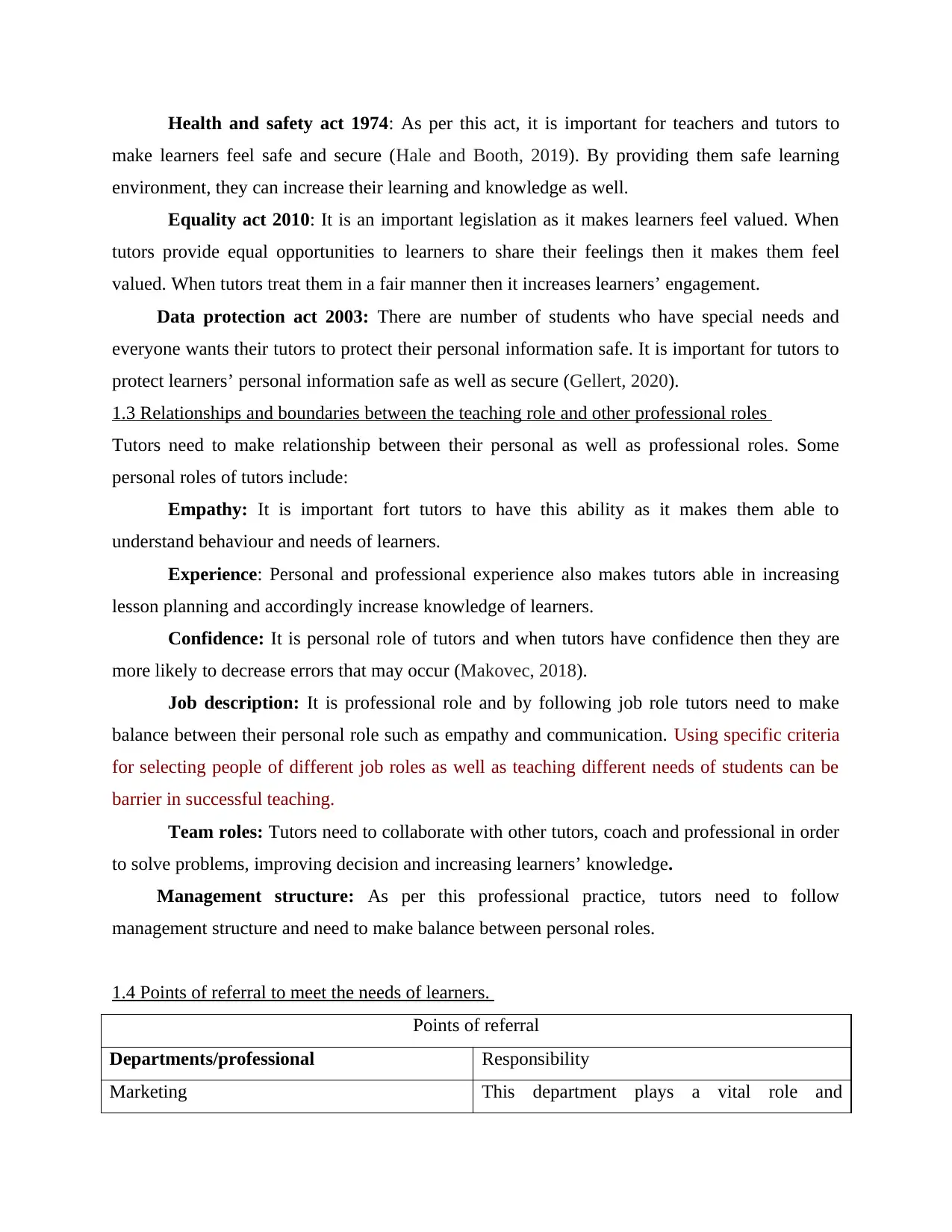
Health and safety act 1974: As per this act, it is important for teachers and tutors to
make learners feel safe and secure (Hale and Booth, 2019). By providing them safe learning
environment, they can increase their learning and knowledge as well.
Equality act 2010: It is an important legislation as it makes learners feel valued. When
tutors provide equal opportunities to learners to share their feelings then it makes them feel
valued. When tutors treat them in a fair manner then it increases learners’ engagement.
Data protection act 2003: There are number of students who have special needs and
everyone wants their tutors to protect their personal information safe. It is important for tutors to
protect learners’ personal information safe as well as secure (Gellert, 2020).
1.3 Relationships and boundaries between the teaching role and other professional roles
Tutors need to make relationship between their personal as well as professional roles. Some
personal roles of tutors include:
Empathy: It is important fort tutors to have this ability as it makes them able to
understand behaviour and needs of learners.
Experience: Personal and professional experience also makes tutors able in increasing
lesson planning and accordingly increase knowledge of learners.
Confidence: It is personal role of tutors and when tutors have confidence then they are
more likely to decrease errors that may occur (Makovec, 2018).
Job description: It is professional role and by following job role tutors need to make
balance between their personal role such as empathy and communication. Using specific criteria
for selecting people of different job roles as well as teaching different needs of students can be
barrier in successful teaching.
Team roles: Tutors need to collaborate with other tutors, coach and professional in order
to solve problems, improving decision and increasing learners’ knowledge.
Management structure: As per this professional practice, tutors need to follow
management structure and need to make balance between personal roles.
1.4 Points of referral to meet the needs of learners.
Points of referral
Departments/professional Responsibility
Marketing This department plays a vital role and
make learners feel safe and secure (Hale and Booth, 2019). By providing them safe learning
environment, they can increase their learning and knowledge as well.
Equality act 2010: It is an important legislation as it makes learners feel valued. When
tutors provide equal opportunities to learners to share their feelings then it makes them feel
valued. When tutors treat them in a fair manner then it increases learners’ engagement.
Data protection act 2003: There are number of students who have special needs and
everyone wants their tutors to protect their personal information safe. It is important for tutors to
protect learners’ personal information safe as well as secure (Gellert, 2020).
1.3 Relationships and boundaries between the teaching role and other professional roles
Tutors need to make relationship between their personal as well as professional roles. Some
personal roles of tutors include:
Empathy: It is important fort tutors to have this ability as it makes them able to
understand behaviour and needs of learners.
Experience: Personal and professional experience also makes tutors able in increasing
lesson planning and accordingly increase knowledge of learners.
Confidence: It is personal role of tutors and when tutors have confidence then they are
more likely to decrease errors that may occur (Makovec, 2018).
Job description: It is professional role and by following job role tutors need to make
balance between their personal role such as empathy and communication. Using specific criteria
for selecting people of different job roles as well as teaching different needs of students can be
barrier in successful teaching.
Team roles: Tutors need to collaborate with other tutors, coach and professional in order
to solve problems, improving decision and increasing learners’ knowledge.
Management structure: As per this professional practice, tutors need to follow
management structure and need to make balance between personal roles.
1.4 Points of referral to meet the needs of learners.
Points of referral
Departments/professional Responsibility
Marketing This department plays a vital role and
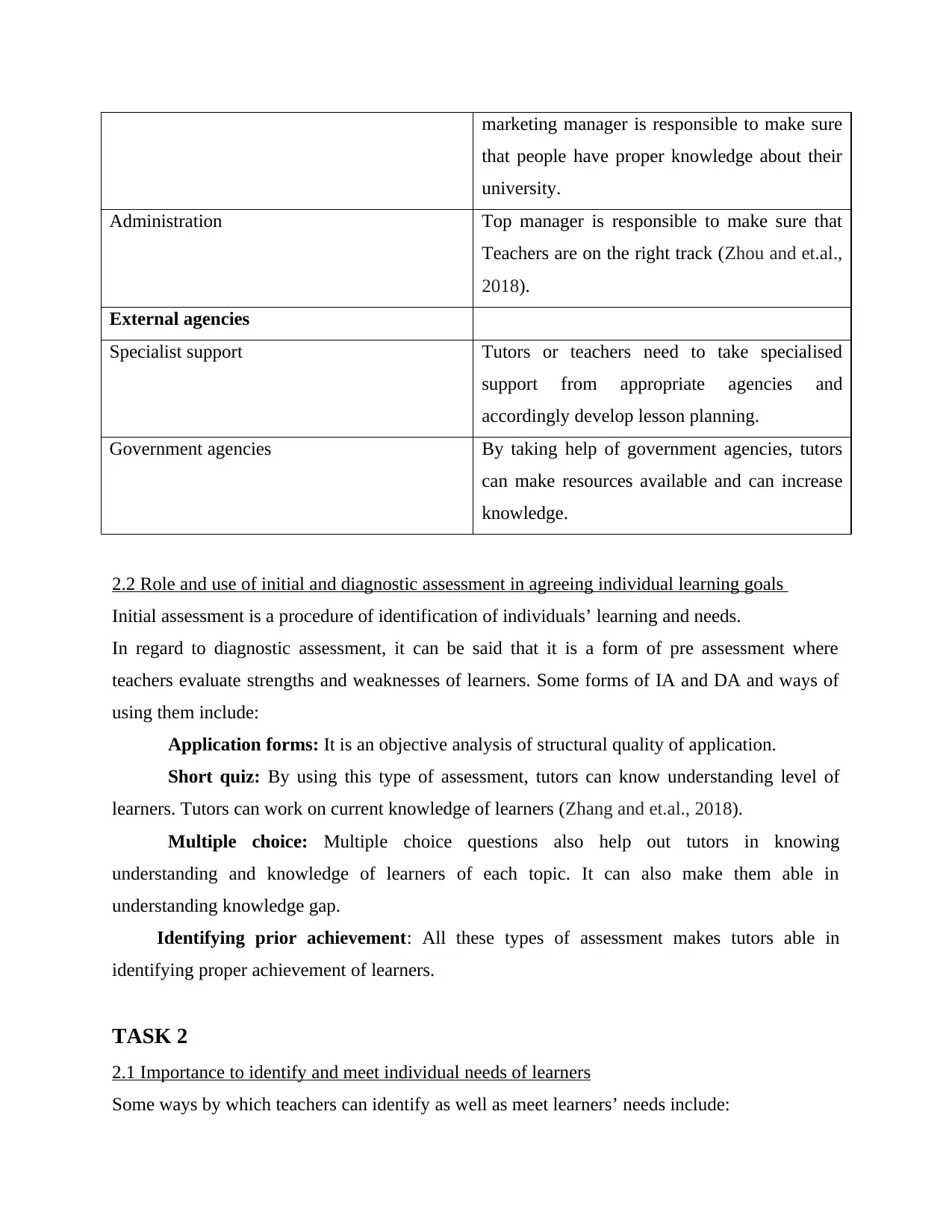
marketing manager is responsible to make sure
that people have proper knowledge about their
university.
Administration Top manager is responsible to make sure that
Teachers are on the right track (Zhou and et.al.,
2018).
External agencies
Specialist support Tutors or teachers need to take specialised
support from appropriate agencies and
accordingly develop lesson planning.
Government agencies By taking help of government agencies, tutors
can make resources available and can increase
knowledge.
2.2 Role and use of initial and diagnostic assessment in agreeing individual learning goals
Initial assessment is a procedure of identification of individuals’ learning and needs.
In regard to diagnostic assessment, it can be said that it is a form of pre assessment where
teachers evaluate strengths and weaknesses of learners. Some forms of IA and DA and ways of
using them include:
Application forms: It is an objective analysis of structural quality of application.
Short quiz: By using this type of assessment, tutors can know understanding level of
learners. Tutors can work on current knowledge of learners (Zhang and et.al., 2018).
Multiple choice: Multiple choice questions also help out tutors in knowing
understanding and knowledge of learners of each topic. It can also make them able in
understanding knowledge gap.
Identifying prior achievement: All these types of assessment makes tutors able in
identifying proper achievement of learners.
TASK 2
2.1 Importance to identify and meet individual needs of learners
Some ways by which teachers can identify as well as meet learners’ needs include:
that people have proper knowledge about their
university.
Administration Top manager is responsible to make sure that
Teachers are on the right track (Zhou and et.al.,
2018).
External agencies
Specialist support Tutors or teachers need to take specialised
support from appropriate agencies and
accordingly develop lesson planning.
Government agencies By taking help of government agencies, tutors
can make resources available and can increase
knowledge.
2.2 Role and use of initial and diagnostic assessment in agreeing individual learning goals
Initial assessment is a procedure of identification of individuals’ learning and needs.
In regard to diagnostic assessment, it can be said that it is a form of pre assessment where
teachers evaluate strengths and weaknesses of learners. Some forms of IA and DA and ways of
using them include:
Application forms: It is an objective analysis of structural quality of application.
Short quiz: By using this type of assessment, tutors can know understanding level of
learners. Tutors can work on current knowledge of learners (Zhang and et.al., 2018).
Multiple choice: Multiple choice questions also help out tutors in knowing
understanding and knowledge of learners of each topic. It can also make them able in
understanding knowledge gap.
Identifying prior achievement: All these types of assessment makes tutors able in
identifying proper achievement of learners.
TASK 2
2.1 Importance to identify and meet individual needs of learners
Some ways by which teachers can identify as well as meet learners’ needs include:
⊘ This is a preview!⊘
Do you want full access?
Subscribe today to unlock all pages.

Trusted by 1+ million students worldwide
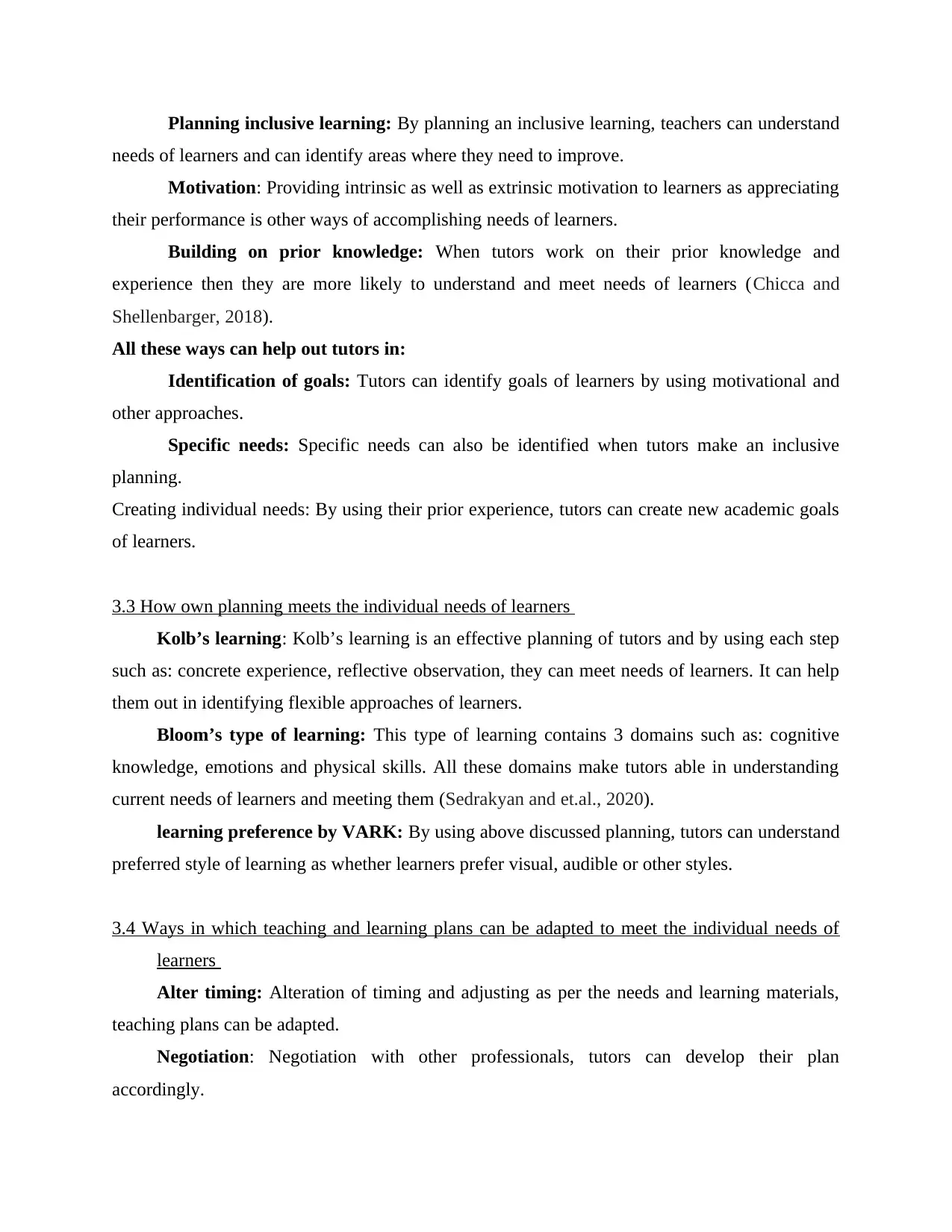
Planning inclusive learning: By planning an inclusive learning, teachers can understand
needs of learners and can identify areas where they need to improve.
Motivation: Providing intrinsic as well as extrinsic motivation to learners as appreciating
their performance is other ways of accomplishing needs of learners.
Building on prior knowledge: When tutors work on their prior knowledge and
experience then they are more likely to understand and meet needs of learners (Chicca and
Shellenbarger, 2018).
All these ways can help out tutors in:
Identification of goals: Tutors can identify goals of learners by using motivational and
other approaches.
Specific needs: Specific needs can also be identified when tutors make an inclusive
planning.
Creating individual needs: By using their prior experience, tutors can create new academic goals
of learners.
3.3 How own planning meets the individual needs of learners
Kolb’s learning: Kolb’s learning is an effective planning of tutors and by using each step
such as: concrete experience, reflective observation, they can meet needs of learners. It can help
them out in identifying flexible approaches of learners.
Bloom’s type of learning: This type of learning contains 3 domains such as: cognitive
knowledge, emotions and physical skills. All these domains make tutors able in understanding
current needs of learners and meeting them (Sedrakyan and et.al., 2020).
learning preference by VARK: By using above discussed planning, tutors can understand
preferred style of learning as whether learners prefer visual, audible or other styles.
3.4 Ways in which teaching and learning plans can be adapted to meet the individual needs of
learners
Alter timing: Alteration of timing and adjusting as per the needs and learning materials,
teaching plans can be adapted.
Negotiation: Negotiation with other professionals, tutors can develop their plan
accordingly.
needs of learners and can identify areas where they need to improve.
Motivation: Providing intrinsic as well as extrinsic motivation to learners as appreciating
their performance is other ways of accomplishing needs of learners.
Building on prior knowledge: When tutors work on their prior knowledge and
experience then they are more likely to understand and meet needs of learners (Chicca and
Shellenbarger, 2018).
All these ways can help out tutors in:
Identification of goals: Tutors can identify goals of learners by using motivational and
other approaches.
Specific needs: Specific needs can also be identified when tutors make an inclusive
planning.
Creating individual needs: By using their prior experience, tutors can create new academic goals
of learners.
3.3 How own planning meets the individual needs of learners
Kolb’s learning: Kolb’s learning is an effective planning of tutors and by using each step
such as: concrete experience, reflective observation, they can meet needs of learners. It can help
them out in identifying flexible approaches of learners.
Bloom’s type of learning: This type of learning contains 3 domains such as: cognitive
knowledge, emotions and physical skills. All these domains make tutors able in understanding
current needs of learners and meeting them (Sedrakyan and et.al., 2020).
learning preference by VARK: By using above discussed planning, tutors can understand
preferred style of learning as whether learners prefer visual, audible or other styles.
3.4 Ways in which teaching and learning plans can be adapted to meet the individual needs of
learners
Alter timing: Alteration of timing and adjusting as per the needs and learning materials,
teaching plans can be adapted.
Negotiation: Negotiation with other professionals, tutors can develop their plan
accordingly.
Paraphrase This Document
Need a fresh take? Get an instant paraphrase of this document with our AI Paraphraser
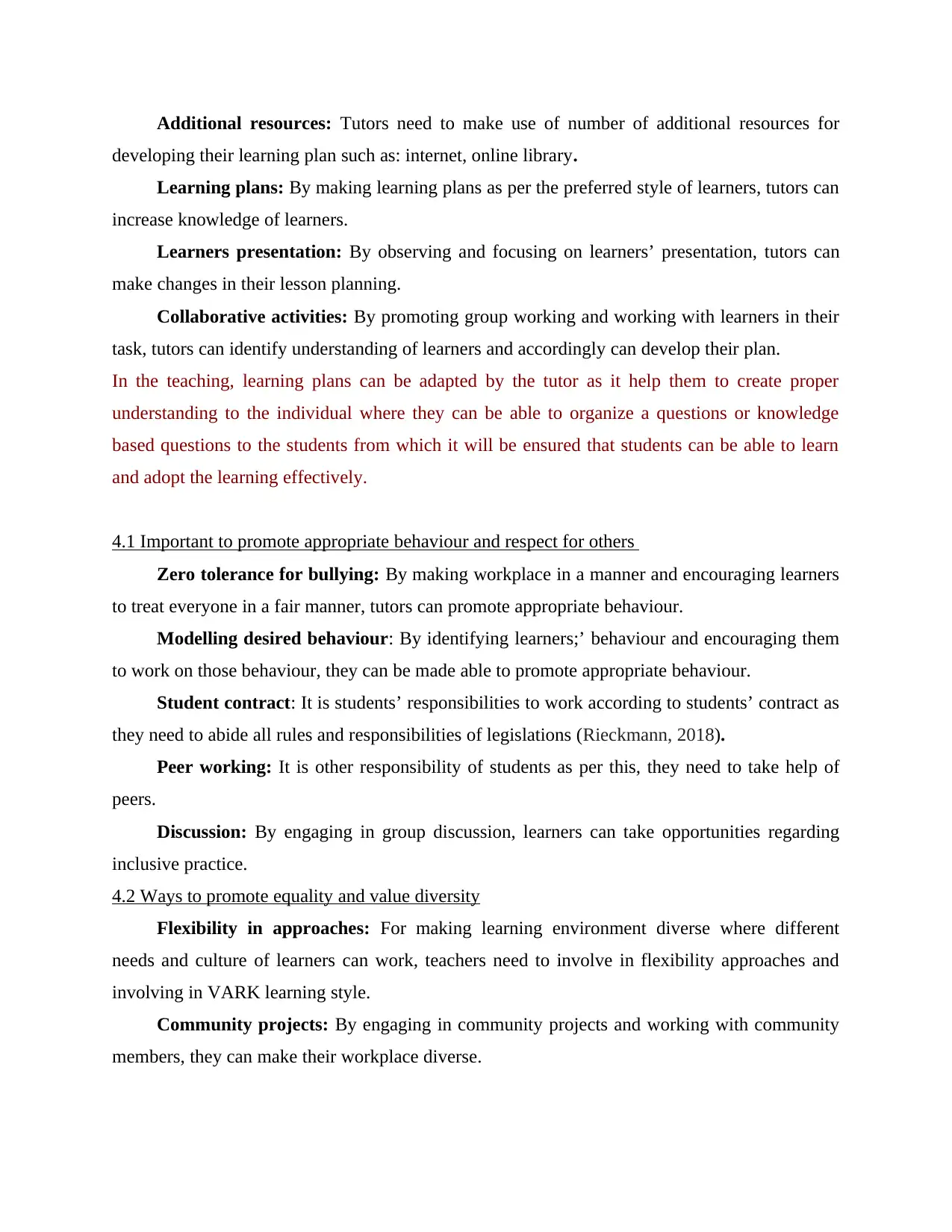
Additional resources: Tutors need to make use of number of additional resources for
developing their learning plan such as: internet, online library.
Learning plans: By making learning plans as per the preferred style of learners, tutors can
increase knowledge of learners.
Learners presentation: By observing and focusing on learners’ presentation, tutors can
make changes in their lesson planning.
Collaborative activities: By promoting group working and working with learners in their
task, tutors can identify understanding of learners and accordingly can develop their plan.
In the teaching, learning plans can be adapted by the tutor as it help them to create proper
understanding to the individual where they can be able to organize a questions or knowledge
based questions to the students from which it will be ensured that students can be able to learn
and adopt the learning effectively.
4.1 Important to promote appropriate behaviour and respect for others
Zero tolerance for bullying: By making workplace in a manner and encouraging learners
to treat everyone in a fair manner, tutors can promote appropriate behaviour.
Modelling desired behaviour: By identifying learners;’ behaviour and encouraging them
to work on those behaviour, they can be made able to promote appropriate behaviour.
Student contract: It is students’ responsibilities to work according to students’ contract as
they need to abide all rules and responsibilities of legislations (Rieckmann, 2018).
Peer working: It is other responsibility of students as per this, they need to take help of
peers.
Discussion: By engaging in group discussion, learners can take opportunities regarding
inclusive practice.
4.2 Ways to promote equality and value diversity
Flexibility in approaches: For making learning environment diverse where different
needs and culture of learners can work, teachers need to involve in flexibility approaches and
involving in VARK learning style.
Community projects: By engaging in community projects and working with community
members, they can make their workplace diverse.
developing their learning plan such as: internet, online library.
Learning plans: By making learning plans as per the preferred style of learners, tutors can
increase knowledge of learners.
Learners presentation: By observing and focusing on learners’ presentation, tutors can
make changes in their lesson planning.
Collaborative activities: By promoting group working and working with learners in their
task, tutors can identify understanding of learners and accordingly can develop their plan.
In the teaching, learning plans can be adapted by the tutor as it help them to create proper
understanding to the individual where they can be able to organize a questions or knowledge
based questions to the students from which it will be ensured that students can be able to learn
and adopt the learning effectively.
4.1 Important to promote appropriate behaviour and respect for others
Zero tolerance for bullying: By making workplace in a manner and encouraging learners
to treat everyone in a fair manner, tutors can promote appropriate behaviour.
Modelling desired behaviour: By identifying learners;’ behaviour and encouraging them
to work on those behaviour, they can be made able to promote appropriate behaviour.
Student contract: It is students’ responsibilities to work according to students’ contract as
they need to abide all rules and responsibilities of legislations (Rieckmann, 2018).
Peer working: It is other responsibility of students as per this, they need to take help of
peers.
Discussion: By engaging in group discussion, learners can take opportunities regarding
inclusive practice.
4.2 Ways to promote equality and value diversity
Flexibility in approaches: For making learning environment diverse where different
needs and culture of learners can work, teachers need to involve in flexibility approaches and
involving in VARK learning style.
Community projects: By engaging in community projects and working with community
members, they can make their workplace diverse.
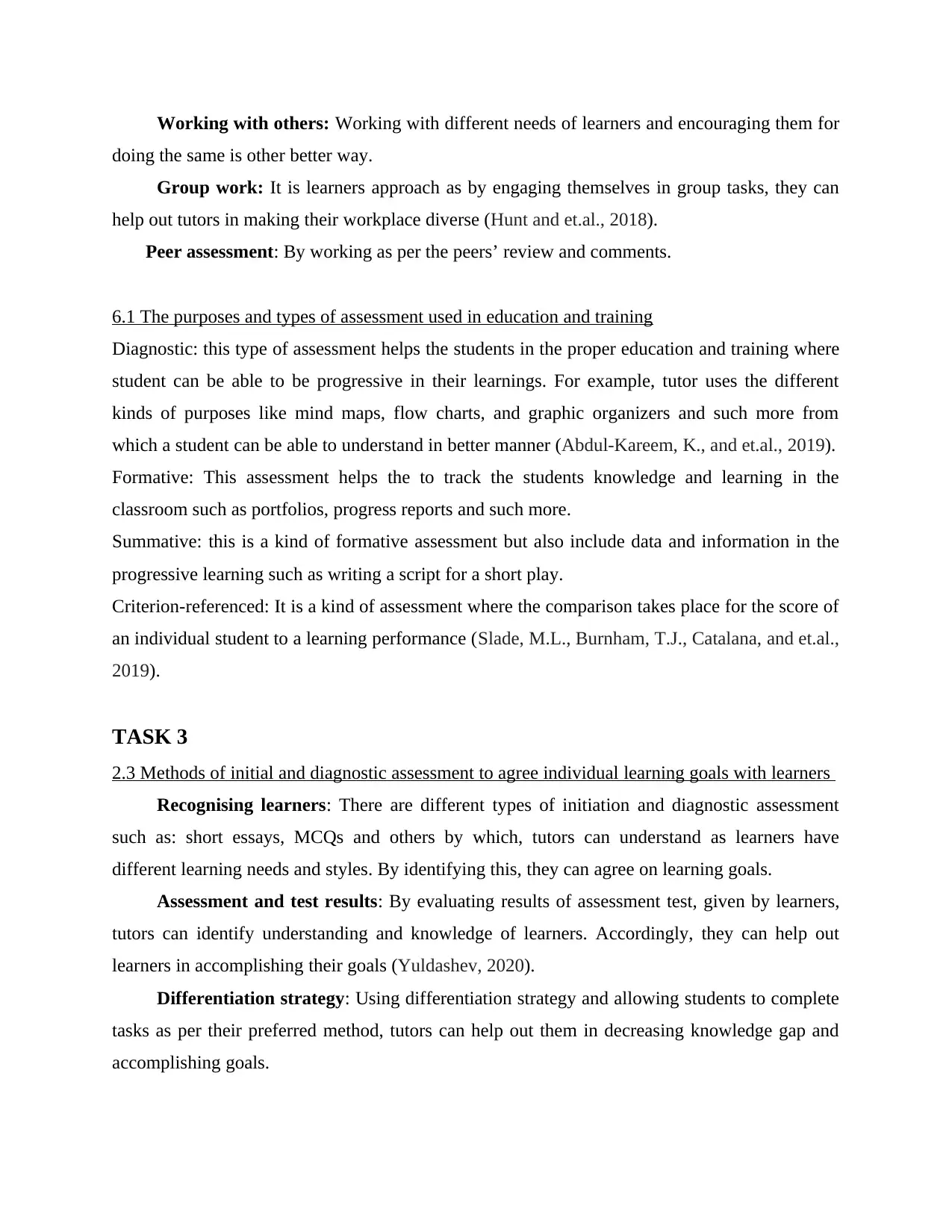
Working with others: Working with different needs of learners and encouraging them for
doing the same is other better way.
Group work: It is learners approach as by engaging themselves in group tasks, they can
help out tutors in making their workplace diverse (Hunt and et.al., 2018).
Peer assessment: By working as per the peers’ review and comments.
6.1 The purposes and types of assessment used in education and training
Diagnostic: this type of assessment helps the students in the proper education and training where
student can be able to be progressive in their learnings. For example, tutor uses the different
kinds of purposes like mind maps, flow charts, and graphic organizers and such more from
which a student can be able to understand in better manner (Abdul‐Kareem, K., and et.al., 2019).
Formative: This assessment helps the to track the students knowledge and learning in the
classroom such as portfolios, progress reports and such more.
Summative: this is a kind of formative assessment but also include data and information in the
progressive learning such as writing a script for a short play.
Criterion-referenced: It is a kind of assessment where the comparison takes place for the score of
an individual student to a learning performance (Slade, M.L., Burnham, T.J., Catalana, and et.al.,
2019).
TASK 3
2.3 Methods of initial and diagnostic assessment to agree individual learning goals with learners
Recognising learners: There are different types of initiation and diagnostic assessment
such as: short essays, MCQs and others by which, tutors can understand as learners have
different learning needs and styles. By identifying this, they can agree on learning goals.
Assessment and test results: By evaluating results of assessment test, given by learners,
tutors can identify understanding and knowledge of learners. Accordingly, they can help out
learners in accomplishing their goals (Yuldashev, 2020).
Differentiation strategy: Using differentiation strategy and allowing students to complete
tasks as per their preferred method, tutors can help out them in decreasing knowledge gap and
accomplishing goals.
doing the same is other better way.
Group work: It is learners approach as by engaging themselves in group tasks, they can
help out tutors in making their workplace diverse (Hunt and et.al., 2018).
Peer assessment: By working as per the peers’ review and comments.
6.1 The purposes and types of assessment used in education and training
Diagnostic: this type of assessment helps the students in the proper education and training where
student can be able to be progressive in their learnings. For example, tutor uses the different
kinds of purposes like mind maps, flow charts, and graphic organizers and such more from
which a student can be able to understand in better manner (Abdul‐Kareem, K., and et.al., 2019).
Formative: This assessment helps the to track the students knowledge and learning in the
classroom such as portfolios, progress reports and such more.
Summative: this is a kind of formative assessment but also include data and information in the
progressive learning such as writing a script for a short play.
Criterion-referenced: It is a kind of assessment where the comparison takes place for the score of
an individual student to a learning performance (Slade, M.L., Burnham, T.J., Catalana, and et.al.,
2019).
TASK 3
2.3 Methods of initial and diagnostic assessment to agree individual learning goals with learners
Recognising learners: There are different types of initiation and diagnostic assessment
such as: short essays, MCQs and others by which, tutors can understand as learners have
different learning needs and styles. By identifying this, they can agree on learning goals.
Assessment and test results: By evaluating results of assessment test, given by learners,
tutors can identify understanding and knowledge of learners. Accordingly, they can help out
learners in accomplishing their goals (Yuldashev, 2020).
Differentiation strategy: Using differentiation strategy and allowing students to complete
tasks as per their preferred method, tutors can help out them in decreasing knowledge gap and
accomplishing goals.
⊘ This is a preview!⊘
Do you want full access?
Subscribe today to unlock all pages.

Trusted by 1+ million students worldwide
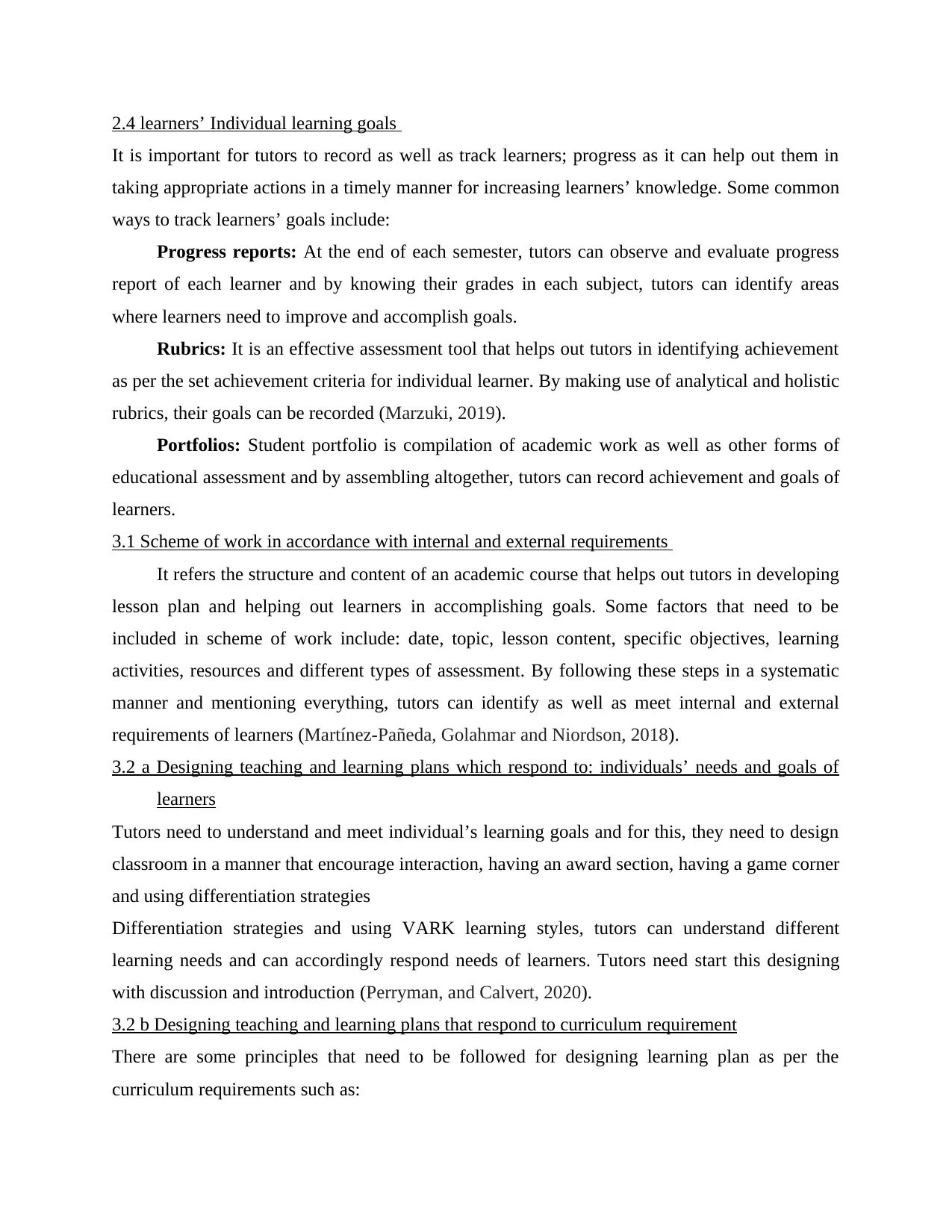
2.4 learners’ Individual learning goals
It is important for tutors to record as well as track learners; progress as it can help out them in
taking appropriate actions in a timely manner for increasing learners’ knowledge. Some common
ways to track learners’ goals include:
Progress reports: At the end of each semester, tutors can observe and evaluate progress
report of each learner and by knowing their grades in each subject, tutors can identify areas
where learners need to improve and accomplish goals.
Rubrics: It is an effective assessment tool that helps out tutors in identifying achievement
as per the set achievement criteria for individual learner. By making use of analytical and holistic
rubrics, their goals can be recorded (Marzuki, 2019).
Portfolios: Student portfolio is compilation of academic work as well as other forms of
educational assessment and by assembling altogether, tutors can record achievement and goals of
learners.
3.1 Scheme of work in accordance with internal and external requirements
It refers the structure and content of an academic course that helps out tutors in developing
lesson plan and helping out learners in accomplishing goals. Some factors that need to be
included in scheme of work include: date, topic, lesson content, specific objectives, learning
activities, resources and different types of assessment. By following these steps in a systematic
manner and mentioning everything, tutors can identify as well as meet internal and external
requirements of learners (Martínez-Pañeda, Golahmar and Niordson, 2018).
3.2 a Designing teaching and learning plans which respond to: individuals’ needs and goals of
learners
Tutors need to understand and meet individual’s learning goals and for this, they need to design
classroom in a manner that encourage interaction, having an award section, having a game corner
and using differentiation strategies
Differentiation strategies and using VARK learning styles, tutors can understand different
learning needs and can accordingly respond needs of learners. Tutors need start this designing
with discussion and introduction (Perryman, and Calvert, 2020).
3.2 b Designing teaching and learning plans that respond to curriculum requirement
There are some principles that need to be followed for designing learning plan as per the
curriculum requirements such as:
It is important for tutors to record as well as track learners; progress as it can help out them in
taking appropriate actions in a timely manner for increasing learners’ knowledge. Some common
ways to track learners’ goals include:
Progress reports: At the end of each semester, tutors can observe and evaluate progress
report of each learner and by knowing their grades in each subject, tutors can identify areas
where learners need to improve and accomplish goals.
Rubrics: It is an effective assessment tool that helps out tutors in identifying achievement
as per the set achievement criteria for individual learner. By making use of analytical and holistic
rubrics, their goals can be recorded (Marzuki, 2019).
Portfolios: Student portfolio is compilation of academic work as well as other forms of
educational assessment and by assembling altogether, tutors can record achievement and goals of
learners.
3.1 Scheme of work in accordance with internal and external requirements
It refers the structure and content of an academic course that helps out tutors in developing
lesson plan and helping out learners in accomplishing goals. Some factors that need to be
included in scheme of work include: date, topic, lesson content, specific objectives, learning
activities, resources and different types of assessment. By following these steps in a systematic
manner and mentioning everything, tutors can identify as well as meet internal and external
requirements of learners (Martínez-Pañeda, Golahmar and Niordson, 2018).
3.2 a Designing teaching and learning plans which respond to: individuals’ needs and goals of
learners
Tutors need to understand and meet individual’s learning goals and for this, they need to design
classroom in a manner that encourage interaction, having an award section, having a game corner
and using differentiation strategies
Differentiation strategies and using VARK learning styles, tutors can understand different
learning needs and can accordingly respond needs of learners. Tutors need start this designing
with discussion and introduction (Perryman, and Calvert, 2020).
3.2 b Designing teaching and learning plans that respond to curriculum requirement
There are some principles that need to be followed for designing learning plan as per the
curriculum requirements such as:
Paraphrase This Document
Need a fresh take? Get an instant paraphrase of this document with our AI Paraphraser
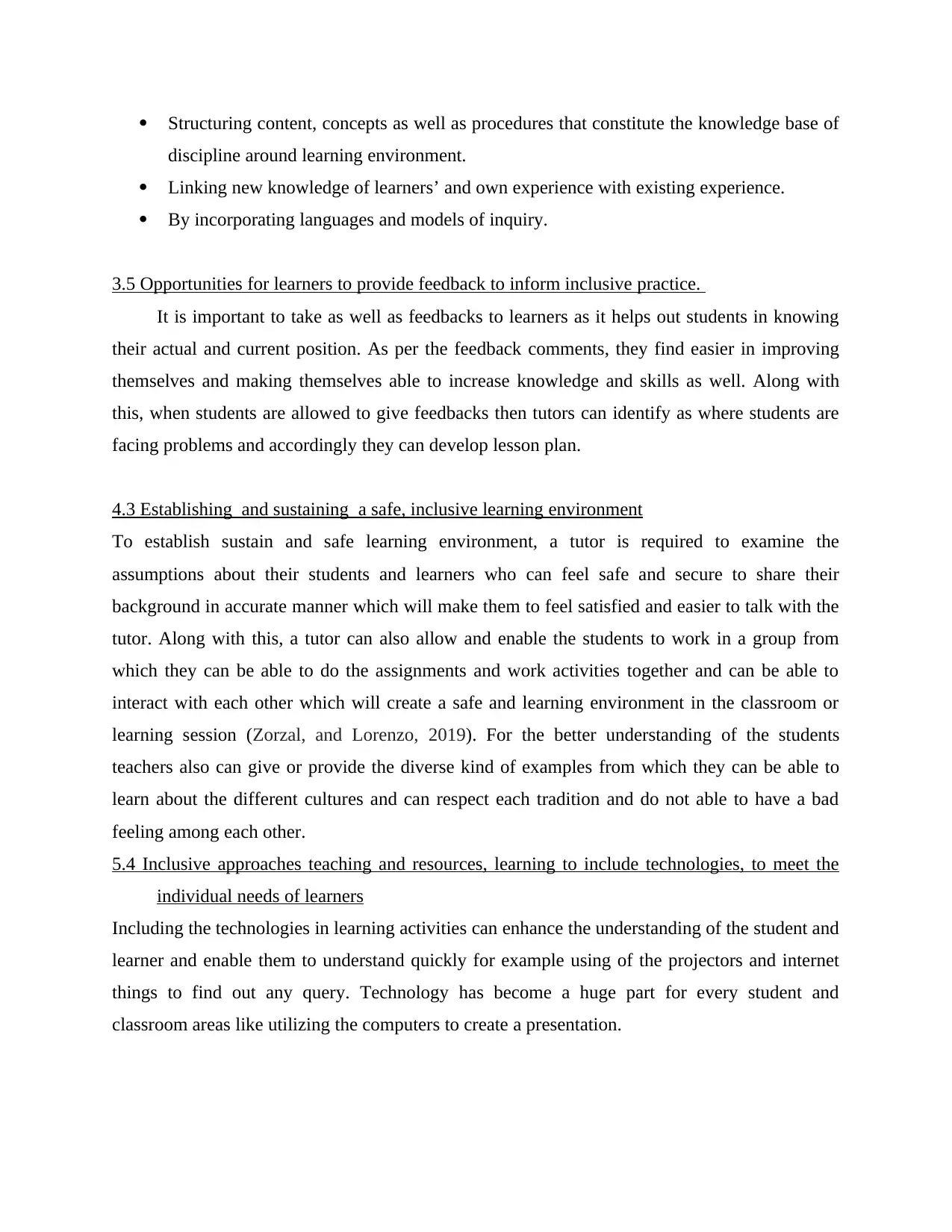
Structuring content, concepts as well as procedures that constitute the knowledge base of
discipline around learning environment.
Linking new knowledge of learners’ and own experience with existing experience.
By incorporating languages and models of inquiry.
3.5 Opportunities for learners to provide feedback to inform inclusive practice.
It is important to take as well as feedbacks to learners as it helps out students in knowing
their actual and current position. As per the feedback comments, they find easier in improving
themselves and making themselves able to increase knowledge and skills as well. Along with
this, when students are allowed to give feedbacks then tutors can identify as where students are
facing problems and accordingly they can develop lesson plan.
4.3 Establishing and sustaining a safe, inclusive learning environment
To establish sustain and safe learning environment, a tutor is required to examine the
assumptions about their students and learners who can feel safe and secure to share their
background in accurate manner which will make them to feel satisfied and easier to talk with the
tutor. Along with this, a tutor can also allow and enable the students to work in a group from
which they can be able to do the assignments and work activities together and can be able to
interact with each other which will create a safe and learning environment in the classroom or
learning session (Zorzal, and Lorenzo, 2019). For the better understanding of the students
teachers also can give or provide the diverse kind of examples from which they can be able to
learn about the different cultures and can respect each tradition and do not able to have a bad
feeling among each other.
5.4 Inclusive approaches teaching and resources, learning to include technologies, to meet the
individual needs of learners
Including the technologies in learning activities can enhance the understanding of the student and
learner and enable them to understand quickly for example using of the projectors and internet
things to find out any query. Technology has become a huge part for every student and
classroom areas like utilizing the computers to create a presentation.
discipline around learning environment.
Linking new knowledge of learners’ and own experience with existing experience.
By incorporating languages and models of inquiry.
3.5 Opportunities for learners to provide feedback to inform inclusive practice.
It is important to take as well as feedbacks to learners as it helps out students in knowing
their actual and current position. As per the feedback comments, they find easier in improving
themselves and making themselves able to increase knowledge and skills as well. Along with
this, when students are allowed to give feedbacks then tutors can identify as where students are
facing problems and accordingly they can develop lesson plan.
4.3 Establishing and sustaining a safe, inclusive learning environment
To establish sustain and safe learning environment, a tutor is required to examine the
assumptions about their students and learners who can feel safe and secure to share their
background in accurate manner which will make them to feel satisfied and easier to talk with the
tutor. Along with this, a tutor can also allow and enable the students to work in a group from
which they can be able to do the assignments and work activities together and can be able to
interact with each other which will create a safe and learning environment in the classroom or
learning session (Zorzal, and Lorenzo, 2019). For the better understanding of the students
teachers also can give or provide the diverse kind of examples from which they can be able to
learn about the different cultures and can respect each tradition and do not able to have a bad
feeling among each other.
5.4 Inclusive approaches teaching and resources, learning to include technologies, to meet the
individual needs of learners
Including the technologies in learning activities can enhance the understanding of the student and
learner and enable them to understand quickly for example using of the projectors and internet
things to find out any query. Technology has become a huge part for every student and
classroom areas like utilizing the computers to create a presentation.
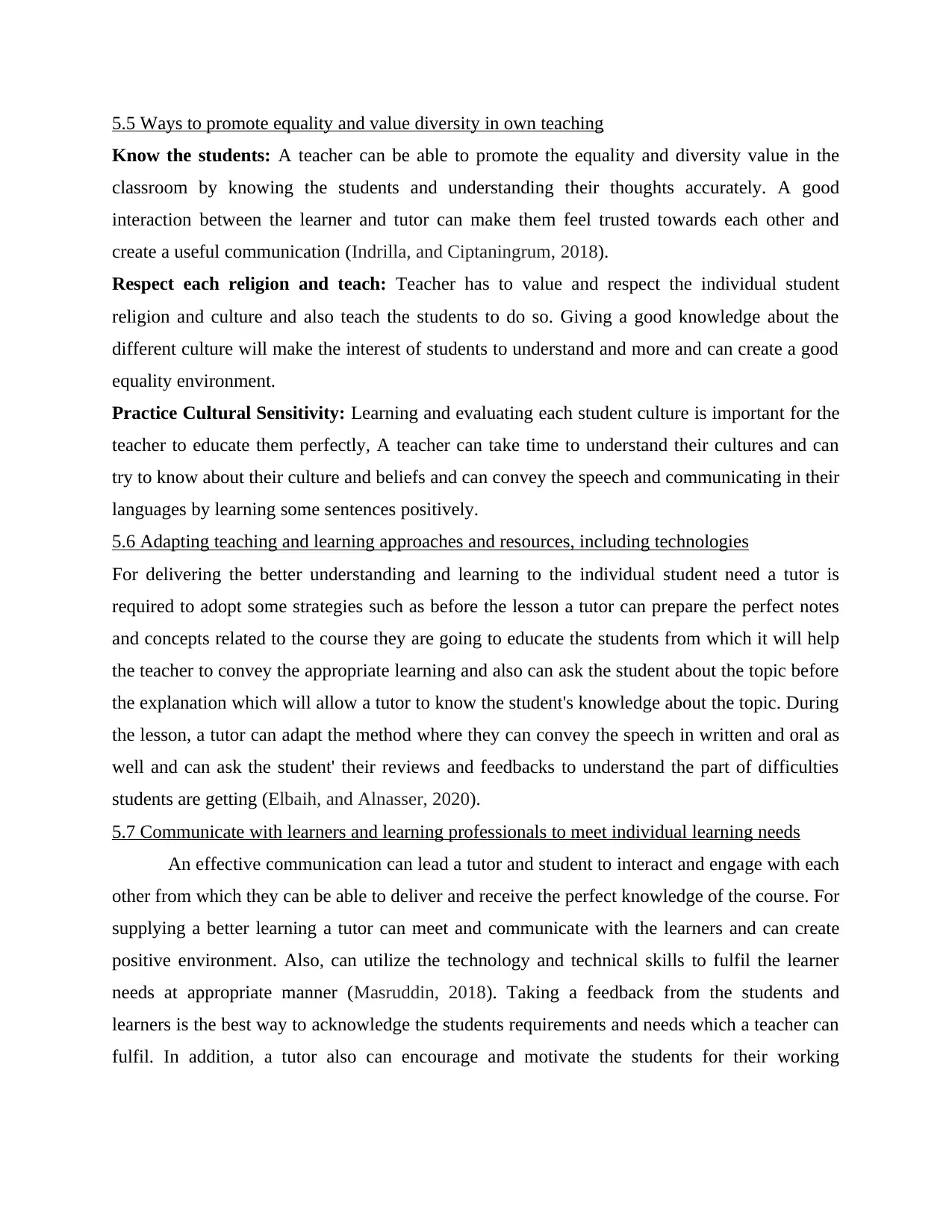
5.5 Ways to promote equality and value diversity in own teaching
Know the students: A teacher can be able to promote the equality and diversity value in the
classroom by knowing the students and understanding their thoughts accurately. A good
interaction between the learner and tutor can make them feel trusted towards each other and
create a useful communication (Indrilla, and Ciptaningrum, 2018).
Respect each religion and teach: Teacher has to value and respect the individual student
religion and culture and also teach the students to do so. Giving a good knowledge about the
different culture will make the interest of students to understand and more and can create a good
equality environment.
Practice Cultural Sensitivity: Learning and evaluating each student culture is important for the
teacher to educate them perfectly, A teacher can take time to understand their cultures and can
try to know about their culture and beliefs and can convey the speech and communicating in their
languages by learning some sentences positively.
5.6 Adapting teaching and learning approaches and resources, including technologies
For delivering the better understanding and learning to the individual student need a tutor is
required to adopt some strategies such as before the lesson a tutor can prepare the perfect notes
and concepts related to the course they are going to educate the students from which it will help
the teacher to convey the appropriate learning and also can ask the student about the topic before
the explanation which will allow a tutor to know the student's knowledge about the topic. During
the lesson, a tutor can adapt the method where they can convey the speech in written and oral as
well and can ask the student' their reviews and feedbacks to understand the part of difficulties
students are getting (Elbaih, and Alnasser, 2020).
5.7 Communicate with learners and learning professionals to meet individual learning needs
An effective communication can lead a tutor and student to interact and engage with each
other from which they can be able to deliver and receive the perfect knowledge of the course. For
supplying a better learning a tutor can meet and communicate with the learners and can create
positive environment. Also, can utilize the technology and technical skills to fulfil the learner
needs at appropriate manner (Masruddin, 2018). Taking a feedback from the students and
learners is the best way to acknowledge the students requirements and needs which a teacher can
fulfil. In addition, a tutor also can encourage and motivate the students for their working
Know the students: A teacher can be able to promote the equality and diversity value in the
classroom by knowing the students and understanding their thoughts accurately. A good
interaction between the learner and tutor can make them feel trusted towards each other and
create a useful communication (Indrilla, and Ciptaningrum, 2018).
Respect each religion and teach: Teacher has to value and respect the individual student
religion and culture and also teach the students to do so. Giving a good knowledge about the
different culture will make the interest of students to understand and more and can create a good
equality environment.
Practice Cultural Sensitivity: Learning and evaluating each student culture is important for the
teacher to educate them perfectly, A teacher can take time to understand their cultures and can
try to know about their culture and beliefs and can convey the speech and communicating in their
languages by learning some sentences positively.
5.6 Adapting teaching and learning approaches and resources, including technologies
For delivering the better understanding and learning to the individual student need a tutor is
required to adopt some strategies such as before the lesson a tutor can prepare the perfect notes
and concepts related to the course they are going to educate the students from which it will help
the teacher to convey the appropriate learning and also can ask the student about the topic before
the explanation which will allow a tutor to know the student's knowledge about the topic. During
the lesson, a tutor can adapt the method where they can convey the speech in written and oral as
well and can ask the student' their reviews and feedbacks to understand the part of difficulties
students are getting (Elbaih, and Alnasser, 2020).
5.7 Communicate with learners and learning professionals to meet individual learning needs
An effective communication can lead a tutor and student to interact and engage with each
other from which they can be able to deliver and receive the perfect knowledge of the course. For
supplying a better learning a tutor can meet and communicate with the learners and can create
positive environment. Also, can utilize the technology and technical skills to fulfil the learner
needs at appropriate manner (Masruddin, 2018). Taking a feedback from the students and
learners is the best way to acknowledge the students requirements and needs which a teacher can
fulfil. In addition, a tutor also can encourage and motivate the students for their working
⊘ This is a preview!⊘
Do you want full access?
Subscribe today to unlock all pages.

Trusted by 1+ million students worldwide
1 out of 23
Related Documents
Your All-in-One AI-Powered Toolkit for Academic Success.
+13062052269
info@desklib.com
Available 24*7 on WhatsApp / Email
![[object Object]](/_next/static/media/star-bottom.7253800d.svg)
Unlock your academic potential
Copyright © 2020–2025 A2Z Services. All Rights Reserved. Developed and managed by ZUCOL.


